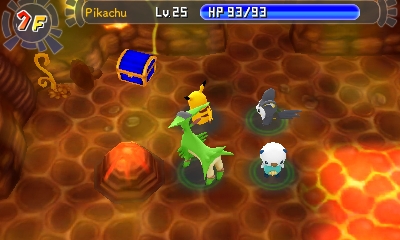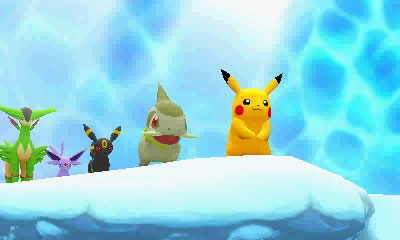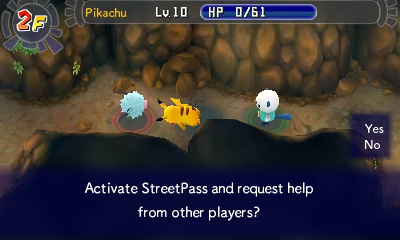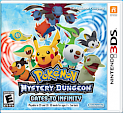Review: Pokémon Mystery Dungeon: Gates to Infinity

Posted 07 Jun 2013 at 14:39 by Paul Muchmore
The Pokémon Mystery Dungeon series is a peculiar one. While traditionally you take the role of a Pokémon trainer, raising you collection of creatures and training for battle, Gates to Infinity sees you play a human transformed into a Pokémon, battling through randomly generated dungeons to find materials to build a paradise for you and all your Pokémon friends.
Mystery Dungeon games, created by Chunsoft, are based on roguelikes – dungeon crawlers characterised by their random nature and permanent death, that challenge the player to get as far as they can without dying. While death in this game will not lose all of your progress, you will lose a random selection of items from your inventory.
In the opening sequence you must choose which Pokémon you will play as – a choice between Pikachu, Oshawott, Snivy, Tepig and Axew, as well as picking which one will be your partner in your quest to create a Pokémon Paradise. While previous entries to the series presented you with a personality test to select your character, Gates to Infinity does away with this to simplify the experience.
 At the core of the game, dungeon crawling is turn-based – for every step you take in the grid-based caves and fields, enemy Pokémon will also move one space at the same time, and for every attack you make, they can attack you back. Each Pokémon has one (useless) basic attack and the usual four special attacks, which are limited by PP and can be changed through levelling up.
At the core of the game, dungeon crawling is turn-based – for every step you take in the grid-based caves and fields, enemy Pokémon will also move one space at the same time, and for every attack you make, they can attack you back. Each Pokémon has one (useless) basic attack and the usual four special attacks, which are limited by PP and can be changed through levelling up.
You will only ever take charge of your own character - your partner and up to two other Pokémon in your party will always be controlled by the computer. Despite the ability to give instructions; they’ll often make stupid decisions or wander off, leaving you in a tight spot. You never feel completely in control of a battle.
The randomly generated dungeons are uninspiring – a series of repeated rooms linked by winding tunnels. There’s no joy in going through them, and no real sense of exploration – you’re simply trying to find the exit, which due to the randomness, could be in the first room you enter, or could be a mile away.
The controls feel clunky, with combinations of the shoulder buttons and ABXY needed to pull off attacks, with the face buttons also used to access your inventory and menus and to interact with the environment. It feels like it could be a lot simpler or utilise the touch screen, which is only used for your dungeon map and menu screens.

When you are outside of dungeons, you see your new town gradually build up, which makes some of the tedium seem worth it. While you can say the main Pokémon series pins a lot of plot on hope and dreams, Gates to Infinity takes it to the next level. It’s so cutesy it firmly places the target audience as kids.
While this would be forgivable – I love a happy story – the dialogue speed is so slow, un-skippable, and overly regular, which means it takes ages to make any progress with the game.
The world itself is beautiful, using 3D models of Pokémon similar to those in the Pokédex 3D app. This makes the world feel a bit livelier than in previous, sprite based games.
Gates to Infinity can’t be accused of not taking advantage of the 3DS’ features (well, apart from the touch screen) – paid DLC is available adding to the already lengthy quest, as well as a “Magnagate” augmented reality feature, which creates portals to new dungeons by finding round objects in real life with the 3DS camera.
 In these, you use a collection of Pokémon separate from the main quest, but any items found and money earned will be transferred to your story mode inventory. I found that these more challenging dungeons a lot more fun and rewarding than those found in the main game, particularly at the early stages.
In these, you use a collection of Pokémon separate from the main quest, but any items found and money earned will be transferred to your story mode inventory. I found that these more challenging dungeons a lot more fun and rewarding than those found in the main game, particularly at the early stages.
There is also a multiplayer mode, in which you can team up with friends locally to battle your way through dungeons, but this is only unlocked after around 8 hours of play. There is also StreetPass integration, which allows you to rescue other players if they’ve been felled in a dungeon, or be revived yourself. While a cool feature, it’s only really useful if a friend or family member also owns the game.
Unfortunately, I don’t feel the roguelike gameplay combines very well with the Pokémon world, and ultimately, the dungeons get very tedious.
While building your paradise town can be very rewarding, you’ll have to be either a fan of the genre or a child who is willing to forgive the repetitive nature of the gameplay.
N-Europe Final Verdict
If you just want to get on with your dungeon crawling, this game isn’t for you, but if you’re open to some long winded, sugary kids’ TV storytelling, and need a Pokémon fix before X and Y arrive later this year, Gates to Infinity could provide you with hours of fun.
- Gameplay3
- Playability3
- Visuals4
- Audio3
- Lifespan4
Final Score
6
Pros
A beautiful 3D Pokémon world
Plenty of content
Kids will love it
Cons
Tedious gameplay
Uninspired, repetitive dungeons
Slow, unskippable diaglogue























